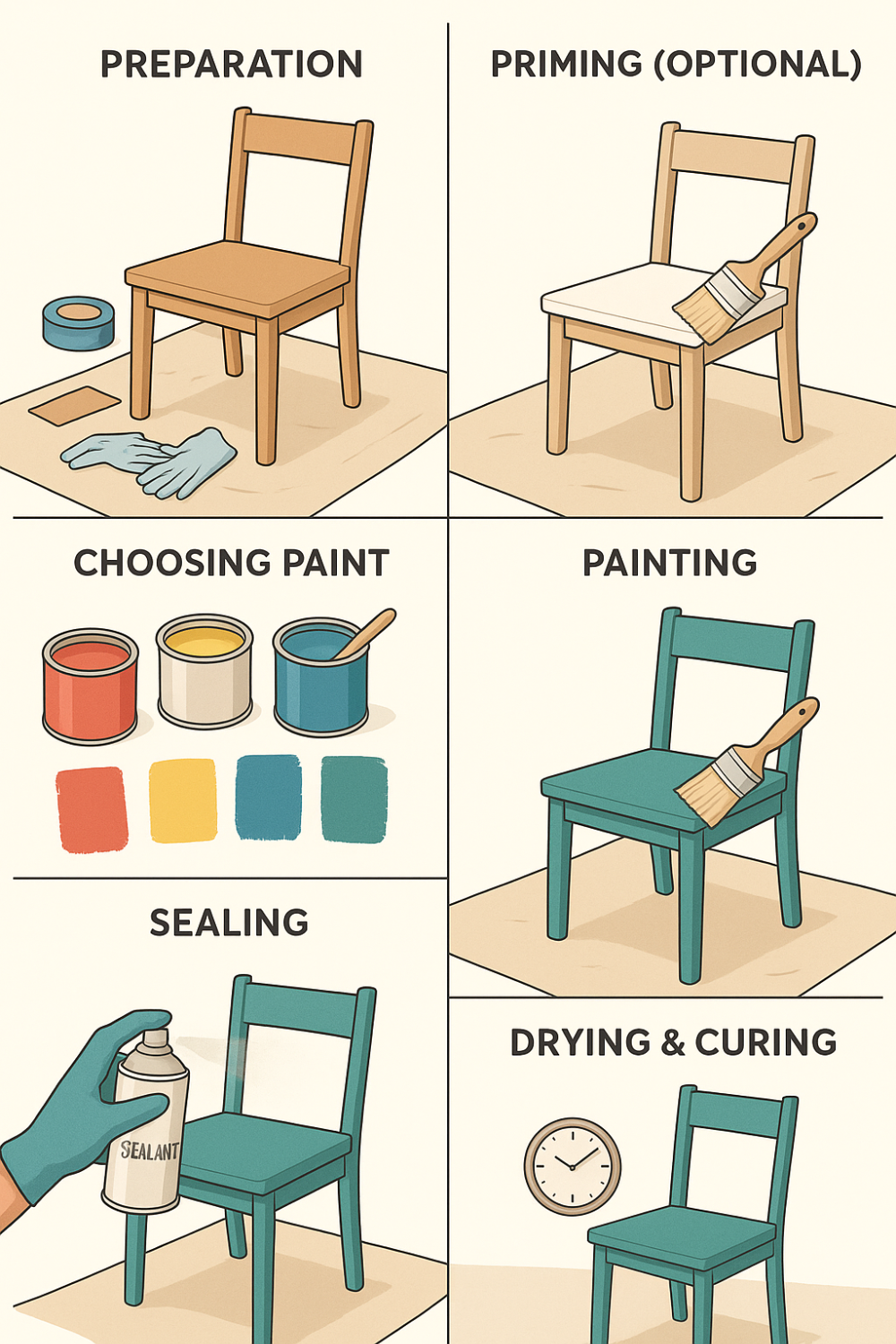If you’re looking to give your furniture a fresh and vibrant look without breaking the bank, acrylic paint could be your new best friend.
Whether it’s an old wooden chair, a tired-looking dresser, or a vintage coffee table, acrylic paint is versatile, easy to use, and perfect for revamping your furniture at home.
Have you ever looked at a piece of furniture and thought, “I wish I could give this a new life, but I have no idea where to start”? Well, you’re not alone. Many people feel the same way about their old furniture but aren’t sure how to approach a DIY makeover.
The truth is, it’s easier than you think, and with the right supplies and technique, you can transform any piece into something that looks like it belongs in a high-end boutique.
In this article, I’ll walk you through everything you need to know to use acrylic paint on furniture from the tools and materials to the step-by-step process, and even the common mistakes to avoid. So, let’s dive in and start giving your furniture a stunning new look!
Why Choose Acrylic Paint for Furniture?
When it comes to furniture makeovers, choosing the right paint is crucial for achieving a long-lasting and smooth finish. While there are various types of paints available, acrylic paint has several distinct advantages that make it an ideal choice for furniture:
- Durability: Acrylic paint is tough, resistant to wear, and can handle the daily hustle and bustle, making it great for furniture that sees frequent use.
- Flexibility: Acrylic paint can be used on many different surfaces like wood, metal, and plastic, making it versatile enough for any type of furniture.
- Quick Drying: Unlike oil-based paints, acrylics dry quickly, reducing your wait time between coats and allowing for a faster project completion.
- Easy Cleanup: Acrylic paints are water-based, which means you can clean brushes and spills with soap and water, without the need for harsh chemicals.
- Eco-Friendly: Acrylic paints are non-toxic and contain fewer volatile organic compounds (VOCs), making them safer for your home and the environment.

Step-by-Step Guide to Using Acrylic Paint on Furniture
1. Preparation is Key: Cleaning and Sanding
Before diving into the fun part painting proper preparation is essential. Taking a few extra steps upfront will ensure your paint sticks properly and gives you a professional finish. Here’s what you need to do:
Clean the Furniture:
- Start by thoroughly cleaning your furniture. Use a mild soap solution or a degreaser to remove dirt, grime, or old wax. If you’re working on a piece with a glossy finish, you’ll want to strip off any old wax or oils that could prevent the new paint from adhering.
- Wipe down the piece with a clean cloth to remove any leftover dust or residue.
Sanding:
- Sanding is an essential step, especially if you’re working with shiny, varnished wood or other smooth surfaces. Use medium-grit sandpaper (around 150 to 220-grit) to lightly scuff up the surface. This creates tiny scratches that help the paint bond to the surface.
- Sand in the direction of the grain for wooden pieces and be sure to sand any edges or areas that are heavily worn.
- Don’t forget to remove all sanding dust with a damp cloth, as this can interfere with your paint’s adhesion.
2. Priming Your Furniture
Why Should You Prime?
Priming is not always necessary, but for certain furniture types, such as those with glossy finishes, a primer can help the paint adhere better and provide a smoother finish. Priming also helps reduce the number of coats of acrylic paint you’ll need.
How to Apply Primer:
- Choose a primer that is appropriate for the type of surface you’re working with wood, metal, or plastic.
- Apply a thin, even layer of primer to the entire piece using a brush or roller. Make sure the primer is spread out uniformly to avoid drips or streaks.
- Allow the primer to dry completely before moving on to the next step.
3. Choosing the Right Acrylic Paint
The beauty of acrylic paints lies in their wide range of options. You can find them in different finishes (matte, satin, gloss) and colors. But it’s important to choose the right one for your specific project.
Here’s what you should keep in mind:
- Type of Finish: Choose a matte finish for a rustic look, satin for a subtle sheen, or gloss for a shiny, high-end appearance.
- Quality of Paint: Higher-quality acrylic paints tend to cover better and provide more durable results. Invest in a trusted brand to get a rich and even coverage.
- Color: Don’t be afraid to experiment with bold colors! Acrylic paint comes in almost every hue, and it’s easy to mix colors to create custom shades. Remember to choose a color that complements your existing decor.
4. Painting the Furniture
Now comes the fun part: painting! Here’s a step-by-step breakdown of the painting process:
Apply the First Coat:
- Using a paintbrush or roller, apply your first coat of acrylic paint. Begin from the top and work your way down to avoid drips.
- Make sure to use smooth, even strokes to prevent streaks or brush marks. If you’re painting intricate details, a small brush might be helpful.
- Allow the first coat to dry fully (typically around 30 minutes to 1 hour, depending on the paint and environmental conditions).
Apply Additional Coats:
- For the best finish, apply 2 to 3 coats of paint, letting each layer dry before applying the next.
- Don’t rush! Allow each coat to dry completely for a flawless finish. Light sanding between coats will help create a smoother surface, especially if you’re going for a more polished look.
5. Sealing the Paint for Protection
Once your acrylic paint has dried completely, it’s important to seal the surface to protect it from scratches, stains, and other potential damage.
Choosing a Sealer:
- You can use a clear acrylic sealer, polyurethane, or varnish depending on the finish you want to achieve. A matte sealer will preserve the low sheen of your paint, while a glossy sealer will give it a shiny, reflective finish.
- Apply a thin coat of sealer using a clean brush, and allow it to dry fully.
Supplies and Steps for Painting Furniture with Acrylic Paint
| Step | Materials Needed | Description |
| 1. Preparation | – Mild soap solution- Degreaser- Sandpaper (150–220 grit)- Clean cloth | Clean and sand your furniture. Sand the surface lightly to create texture for better paint adhesion. |
| 2. Priming (Optional) | – Furniture primer- Paintbrush or roller | Apply a thin, even layer of primer if necessary, depending on the surface material (wood, metal, etc.). |
| 3. Choosing Paint | – Acrylic paint (desired finish: matte, satin, gloss) | Choose a high-quality acrylic paint in your preferred finish and color. |
| 4. Painting | – Paintbrush or foam roller- Drop cloth or tarp | Apply the first coat of acrylic paint, ensuring smooth strokes. Allow each coat to dry before adding another. |
| 5. Sealing | – Clear acrylic sealer- Paintbrush or spray can | After painting, apply a clear sealer to protect the surface from wear and tear. |
| 6. Drying & Curing | – Drying space with good ventilation | Allow each layer to dry completely before applying the next. For best results, let the paint cure for 24 hours. |
Common Mistakes to Avoid When Using Acrylic Paint on Furniture
While using acrylic paint on furniture is a relatively easy process, there are some common mistakes that can negatively impact your final result. Here’s what to watch out for:
- Skipping the Prep Work: Don’t skip cleaning and sanding! If the surface isn’t properly prepped, the paint may not stick properly, and you might end up with an uneven finish.
- Using Low-Quality Paint: Cheaper paints may not offer good coverage and can leave streaks or patches that make your furniture look unfinished.
- Not Waiting for Coats to Dry: Rushing through the drying process can lead to smudging or streaking. Make sure each coat is dry before applying the next.
- Overloading the Brush: A common mistake is using too much paint on your brush. This can cause drips, uneven layers, or brush strokes that are hard to fix later.
- Skipping the Sealer: Without a sealer, your furniture will be more susceptible to wear and tear. Don’t skip this crucial step!
Helpful Tips for a Professional-Looking Finish
- Use a Foam Roller for Smooth Surfaces: For larger, flat areas, a foam roller can help you achieve a smooth, even coat without brush marks.
- Brush with the Grain: When painting wood, always brush along the grain to prevent streaks and ensure the paint lays evenly.
- Consider Layering Colors: If you want a more unique and creative finish, try layering different colors or using a technique like dry brushing to add texture and depth.
Conclusion: Ready to Revamp Your Furniture?
As you can see, painting furniture with acrylic paint is a straightforward process that requires patience and the right technique. Whether you’re working on a vintage find or simply want to give your current furniture a facelift, the possibilities are endless with acrylics.
Follow the steps, avoid the common pitfalls, and you’ll have a beautiful, custom piece in no time.
Your Next Steps:
Now that you’ve got all the tips and tricks to paint your furniture like a pro, it’s time to put your knowledge to the test. Take a look at your furniture pieces and think about how acrylic paint could transform them.
FAQ: Your Acrylic Painting Questions Answered
Q1: How long does acrylic paint take to dry on furniture?
A1: Acrylic paint typically dries within 30 minutes to an hour, depending on the humidity and temperature. However, it’s best to wait 1-2 hours before applying the next coat.
Q2: Can I use acrylic paint on plastic furniture?
A2: Yes, you can use acrylic paint on plastic furniture. Just be sure to clean and prime the surface properly to ensure the paint adheres well.
Q3: Do I need a special brush for acrylic painting on furniture?
A3: It’s not necessary to use a special brush, but using high-quality brushes will give you smoother, more even results. Consider using a synthetic bristle brush for better paint application.
Q4: How long will the painted furniture last?
A4: With proper preparation and sealing, acrylic paint can last for years, even on frequently used furniture. Sealing the paint ensures long-term durability and protection.
Q5: Can I repaint furniture with acrylic paint if it starts to chip or fade?
A5: Absolutely! If your painted furniture starts to show signs of wear, you can lightly sand the surface and repaint it to restore its beauty.



